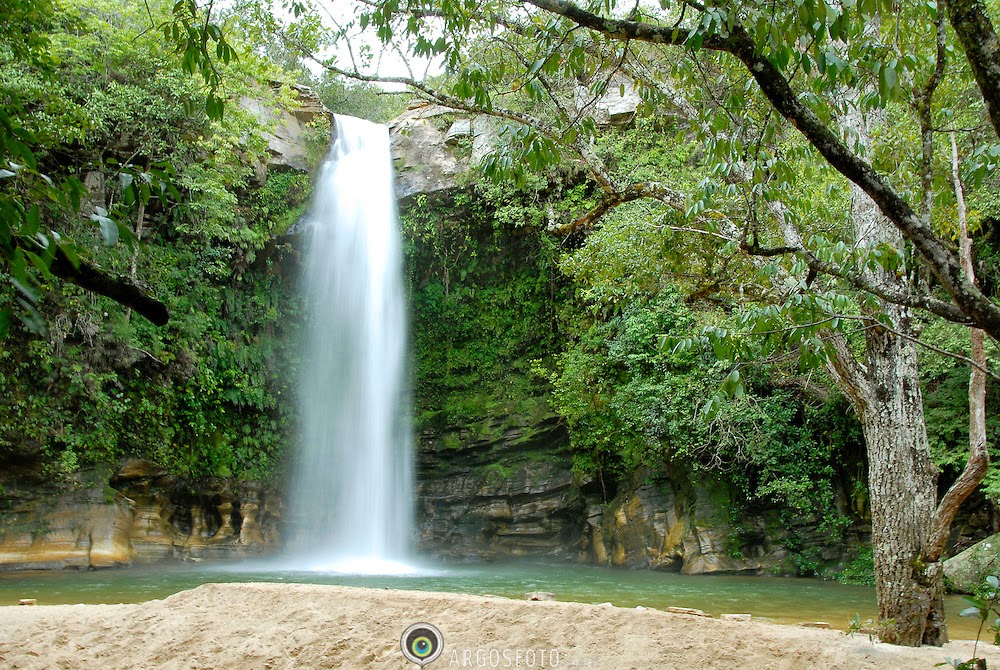Caldas Novas and Rio Quente
The Caminho das Águas (Trail of the Waters) mixes the hot waters of thermal sources with the dammed lakes of the hydroelectric power stations in the valley of the Paranaíba River. The hot waters are found in the counties of Caldas Novas and Rio Quente, which compose the third largest hotel park and the largest hydrothermal complex of Brazil. In the south, the lakes of Emborcação, Lago Azul, São Simão and Cachoeira Dourada, formed by several dams for hydroelectric power plants, are used for water sports and leisure. In the Municipality of Lagoa Santa, southeast of Goiás, the lake of the same name is a unique attraction with its hot medicinal waters.
 |
| Caldas Novas Entrance |
It's located 300 km from Brasília, 150 km from Goiânia and 750 km from São Paulo. As of this writing only charter flights are available to the airport (CLV). If you are not on a packaged tour, the best way to get here is first go to Goiânia or Brasilia and either rent a car or take a bus to Caldas Novas.
Get Around: A rental car is the best way to get around, second best is taxi and/or very inexpensive moto taxi. You will want to visit Hot Park in the sister town of Rio Quente 15 km from Caldas Novas. An intermunicipal will take you to Hot Park and back for a very low fare.
Do:
- Hot Park is the largest water park in Brazil - get there early you will want to spend the entire day there and be sure to bring your sun block.
- Club Di Roma is smaller than Hot Park, but definitely worth spending a day there.
- Nautico Praia Club is located on the 64 km2 lake Corumbá, great for jet skis.
- Lagoa Quente is located 6 km from the center of Caldas Novas and in addition to Hot water pools has such diversions as paint ball.
- There are many other diversions and attractions in the area.
See: If you want to see how nature has blessed the cerrado region you will visit the Parque Ecológico Serra de Caldas, the park is 123 km2 in area and has waterfalls and trails.
The Jardim Japonês is a beautiful garden and is great for taking pictures
Farmers will want to see the Museu da Soja (soybean Museum)
Rio Quente: One of the largest hot water resort complexes in the world - Rio Quente Resorts - is located 20 kilometers to the west of Caldas in the municipality of Rio Quente. With seven hotels, a convention center, and 500 square kilometers of space it receives more than 1 million tourists a year.
Rio Quente is a small town and municipality in the south of the state of Goiás, Brazil. It is the site of a hot water spa known all over the country.
Located in the municipality of Rio Quente, in the state of Goiás, Rio Quente Resorts is in one of the most centralized areas of the country. Its exotic beauty, mild climate, and rich fauna and flora, along with the thermal water springs, make Rio Quente Resorts a unique place of pleasure and sensation.
The resort has an extensive area of native vegetation, where different palm trees display their clusters and leaves. Rio Quente Resorts, and especially the Parque das Fontes (Springs Park), are habitats of various wild bird species (toucans, doves, pigeons, passerine birds, canaries, partridges, parrots, humming birds, macaws, and more).
The Hot Park is one of the top attractions of Rio Quente Resorts. It is a water park with amusement equipment and the only one in the world with natural hot waters.
The entertainment team, specialized in recreation for youth and adults, also offers children activities all day long. They range from soil and water gymnastics, games, treasure hunting, parlor games, ecological walks, art play, team contests, underwater fishing, water basketball, night walks, hunting the “Gruns,” and lunch with team supervisors.































































